Hysteresis in the voltage dependence of HCN channels: conversion between two modes affects pacemaker properties
- PMID: 15710913
- PMCID: PMC2234019
- DOI: 10.1085/jgp.200409130
Hysteresis in the voltage dependence of HCN channels: conversion between two modes affects pacemaker properties
Abstract
Hyperpolarization-activated, cyclic nucleotide-gated (HCN) ion channels are important for rhythmic activity in the brain and in the heart. In this study, using ionic and gating current measurements, we show that cloned spHCN channels undergo a hysteresis in their voltage dependence during normal gating. For example, both the gating charge versus voltage curve, Q(V), and the conductance versus voltage curve, G(V), are shifted by about +60 mV when measured from a hyperpolarized holding potential compared with a depolarized holding potential. In addition, the kinetics of the tail current and the activation current change in parallel to the voltage shifts of the Q(V) and G(V) curves. Mammalian HCN1 channels display similar effects in their ionic currents, suggesting that the mammalian HCN channels also undergo voltage hysteresis. We propose a model in which HCN channels transit between two modes. The voltage dependence in the two modes is shifted relative to each other, and the occupancy of the two modes depends on the previous activation of the channel. The shifts in the voltage dependence are fast (tau approximately 100 ms) and are not accompanied by any apparent inactivation. In HCN1 channels, the shift in voltage dependence is slower in a 100 mM K extracellular solution compared with a 1 mM K solution. Based on these findings, we suggest that molecular conformations similar to slow (C-type) inactivation of K channels underlie voltage hysteresis in HCN channels. The voltage hysteresis results in HCN channels displaying different voltage dependences during different phases in the pacemaker cycle. Computer simulations suggest that voltage hysteresis in HCN channels decreases the risk of arrhythmia in pacemaker cells.
Figures
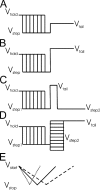

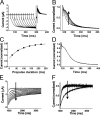
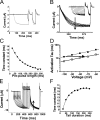







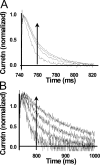
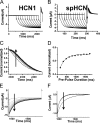
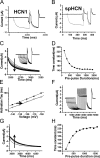


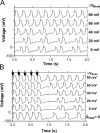
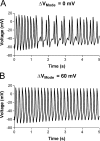

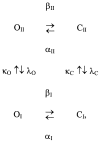

References
-
- Aggarwal, S.K., and R. MacKinnon. 1996. Contribution of the S4 segment to gating charge in the Shaker K+ channel. Neuron. 16:1169–1177. - PubMed
-
- Armstrong, C.M., and F. Bezanilla. 1973. Currents related to movement of the gating particles of the sodium channels. Nature. 242:459–461. - PubMed
-
- Baruscotti, M., and D. DiFrancesco. 2004. Pacemaker channels. Ann. NY Acad. Sci. 1015:111–121. - PubMed
-
- Bezanilla, F., E. Perozo, D.M. Papazian, and E. Stefani. 1991. Molecular basis of gating charge immobilization in Shaker potassium channels. Science. 254:679–683. - PubMed
Publication types
MeSH terms
Substances
Grants and funding
LinkOut - more resources
Full Text Sources
Other Literature Sources
Molecular Biology Databases
Miscellaneous

